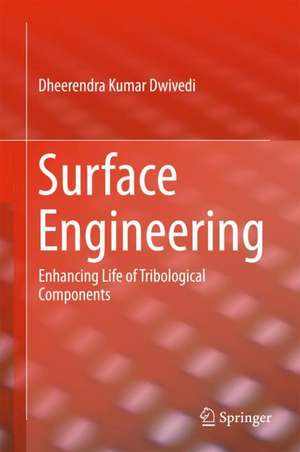Surface Engineering: Enhancing Life of Tribological Components
Autor Dheerendra Kumar Dwivedien Limba Engleză Hardback – 13 apr 2018
| Toate formatele și edițiile | Preț | Express |
|---|---|---|
| Paperback (1) | 581.98 lei 3-5 săpt. | |
| Springer India – 16 dec 2018 | 581.98 lei 3-5 săpt. | |
| Hardback (1) | 731.28 lei 3-5 săpt. | |
| Springer India – 13 apr 2018 | 731.28 lei 3-5 săpt. |
Preț: 731.28 lei
Preț vechi: 891.81 lei
-18% Nou
Puncte Express: 1097
Preț estimativ în valută:
139.97€ • 152.09$ • 117.65£
139.97€ • 152.09$ • 117.65£
Carte disponibilă
Livrare economică 31 martie-14 aprilie
Preluare comenzi: 021 569.72.76
Specificații
ISBN-13: 9788132237778
ISBN-10: 8132237773
Pagini: 266
Ilustrații: XIII, 224 p. 183 illus., 37 illus. in color.
Dimensiuni: 155 x 235 mm
Greutate: 0.55 kg
Ediția:1st ed. 2018
Editura: Springer India
Colecția Springer
Locul publicării:New Delhi, India
ISBN-10: 8132237773
Pagini: 266
Ilustrații: XIII, 224 p. 183 illus., 37 illus. in color.
Dimensiuni: 155 x 235 mm
Greutate: 0.55 kg
Ediția:1st ed. 2018
Editura: Springer India
Colecția Springer
Locul publicării:New Delhi, India
Cuprins
Surface Engineering.- Surface Damage: Causes and Mechanisms.- Materials for Controlling the Wear.- Surface Engineering by Changing the Surface Metallurgy.- Surface Engineering by Changing the Composition.- Surface Modification by Developing Coating, and Cladding.- Characterization of Engineered Surfaces.
Notă biografică
Dheerendra Kumar Dwivedi, PhD, is Professor in the Department of Mechanical and Industrial Engineering, Indian Institute of Technology Roorkee. He has been involved in teaching, research and development, industrial consultancy for the last 20 years broadly in the area of manufacturing technologies in general and casting, welding and surfacing modification for improved mechanical properties in particular. He has developed more than 100 hours video lectures in area of manufacturing technologies under NPTEL program of MHRD Govt. of India. He supervised 10 PhD thesis and more than 50 M. Tech. dissertation. He has published in more than 100 research papers in peer reviewed SCI and SCIE indexed International Journal with h factor 21 and i-10 index 43. He has published a book on production and properties of cast Al-Si alloys with New Age International, New Delhi. He has executed more than 16 R & D project and 50 industrial consultancy project of worth Rs. 50 Millions. He has undertakenfive bilateral international collaborative research projects with reputed university namely Chemnitz University, Germany, University of Coimbra, Portugal, University of Uberlandia, Brazil, University of Zacatecas, Mexico and Physical Technical Institute, Minsk, Belarus. Author has undertaken research projects in the area of oxy-fuel flame and high velocity oxy-fuel spraying for improved abrasive and erosive wear resistance, laser cladding of none-cobalt base alloys for improved cavitation resistance, laser assisted nitriding and ion implantation cast martensitic stainless steel for improved erosion resistance, friction stir processing of cast Al-Si alloys, Ni-Al-Bronzes from funding agencies namely DST, BRNS, MHRD, CSIR etc.
Textul de pe ultima copertă
This book is intended to help engineers analyze service condition and potential mechanisms of surface degradation. This will enable engineers select suitable materials for improved service-life and performance of engineering components. The book comprises 7 chapters, and is well illustrated with schematics, photographs, microstructure, XRD patterns, EDAX mapping, and technical data tables. The book focuses on the influence of materials and methods of surface engineering on structure, properties, and wear-performance of engineering components. It begins with the need to study the subject of surface engineering, scope of surface engineering, and classification of techniques of surface engineering. The book covers conventional material system (steel, cast iron, stellite, WC-Co, PCDs, etc.) and new materials like multilayer structures, functionally gradient materials (FGMs), intermetallic barrier coatings, and thermal barrier coating. The book covers most conventional as well as advanced surface engineering techniques, such as burnishing, shot peening, flame and induction hardening, laser and electron beam hardening, plasma and TIG melting, carburizing, nitriding, cyaniding, boronizing, vanadizing, ion implantation, laser alloying, chemical vapor deposition, PE chemical vapor deposition, physical vapor deposition, weld overlays, laser cladding, hot dip galvanizing, hot dip lead tin coating, hot dip aluminizing, hot dip chromizing, electroplating, electroless plating (Ni-P and Ni-B), mechanical plating, roll bonding, explosive bonding, and hot isostatic. The book also includes an introductory chapter on friction-stir processing of aluminum and titanium alloys. Further, it discusses studies on structure, mechanical and wear properties of weld surfacing, flame spray coating, HVOF sprayed coating, laser cladding of ferrous metals, nickel and cobalt based alloys and their composites in as-sprayed and heat-treated conditions. The book provides a comprehensive overview of various destructive and nondestructive techniques used for characterization of engineered surfaces. The materials in the book will be useful to undergraduate and graduate students. In addition, the contents of this book can also be used for professional development courses for practicing engineers.
Caracteristici
Covers most conventional as well as advanced surface engineering techniques Intends to help engineers analyze service condition and potential mechanisms of surface degradation Comprises of chapters illustrated with schematics, photographs, microstructure, XRD patterns, EDAX mapping, and technical data tables
